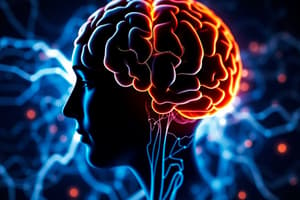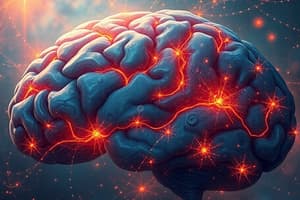Podcast
Questions and Answers
What is a key distinction between working memory (WM) and long-term memory (LTM)?
What is a key distinction between working memory (WM) and long-term memory (LTM)?
- LTM is primarily involved in processing visual information, while WM is focused on auditory information.
- WM stores semantic knowledge, while LTM stores episodic memories.
- WM has a limited capacity and short duration, while LTM has a vast capacity and can store information for a long time. (correct)
- LTM is responsible for complex cognitive tasks, such as Raven's Progressive Matrices, whereas WM handles simple arithmetic.
How do Raven's Progressive Matrices relate to working memory (WM) capacity?
How do Raven's Progressive Matrices relate to working memory (WM) capacity?
- Raven's Progressive Matrices primarily rely on long-term memory, not working memory.
- Individuals with lower WM capacity tend to perform better on Raven's Progressive Matrices due to focused attention.
- Performance on Raven's Progressive Matrices is independent of WM capacity.
- Higher WM capacity generally correlates with better performance on Raven's Progressive Matrices, as it requires holding and manipulating multiple pieces of information. (correct)
What does the 'reading span' task measure in the context of working memory?
What does the 'reading span' task measure in the context of working memory?
- The number of sentences a person can read in a given time.
- The number of final words from a series of sentences a person can remember in order. (correct)
- The ability to read quickly and accurately.
- The comprehension level of complex texts.
How does working memory (WM) performance generally change with age, and what is a potential reason for this change?
How does working memory (WM) performance generally change with age, and what is a potential reason for this change?
Patient H.M. had his medial temporal lobe removed and suffered from anterograde amnesia. What does this tell us about working memory?
Patient H.M. had his medial temporal lobe removed and suffered from anterograde amnesia. What does this tell us about working memory?
In the context of the tripartite theory of working memory, what is the role of the central executive?
In the context of the tripartite theory of working memory, what is the role of the central executive?
What does the 'acoustic similarity effect' suggest about the phonological loop?
What does the 'acoustic similarity effect' suggest about the phonological loop?
What is the purpose of articulatory suppression in experiments studying the phonological loop?
What is the purpose of articulatory suppression in experiments studying the phonological loop?
How does the 'word length effect' relate to the phonological loop?
How does the 'word length effect' relate to the phonological loop?
What does the concept of 'chunking' suggest about the capacity of working memory?
What does the concept of 'chunking' suggest about the capacity of working memory?
What general function is associated with Broca's area, in the context of working memory?
What general function is associated with Broca's area, in the context of working memory?
In the context of Baddeley's working memory model, what is the primary function of the visuospatial buffer (or sketchpad)?
In the context of Baddeley's working memory model, what is the primary function of the visuospatial buffer (or sketchpad)?
What does the dual-task paradigm, as demonstrated by Brooks' (1968) experiment, reveal about the relationship between the visuospatial sketchpad and the phonological loop?
What does the dual-task paradigm, as demonstrated by Brooks' (1968) experiment, reveal about the relationship between the visuospatial sketchpad and the phonological loop?
What is a key characteristic of a 'double dissociation' in neuropsychological research, such as studies involving working memory?
What is a key characteristic of a 'double dissociation' in neuropsychological research, such as studies involving working memory?
What are some common symptoms associated with frontal lobe syndrome that relate to working memory and executive functions?
What are some common symptoms associated with frontal lobe syndrome that relate to working memory and executive functions?
According to the 'sensory recruitment' or 'sensorimotor recruitment' hypothesis, how are working memory representations thought to be maintained?
According to the 'sensory recruitment' or 'sensorimotor recruitment' hypothesis, how are working memory representations thought to be maintained?
What is the primary role of 'supervising attention' as a function of the central executive in working memory?
What is the primary role of 'supervising attention' as a function of the central executive in working memory?
In the context of interference effects in reasoning, what does performing a random number generation task concurrently with a syllogism task demonstrate?
In the context of interference effects in reasoning, what does performing a random number generation task concurrently with a syllogism task demonstrate?
Why do some researchers propose the idea of 'infinite buffers' in distributed working memory representations?
Why do some researchers propose the idea of 'infinite buffers' in distributed working memory representations?
What is the primary difference between the '2-back' task and the 'search' task, as measured by PET scans in studies of working memory?
What is the primary difference between the '2-back' task and the 'search' task, as measured by PET scans in studies of working memory?
Flashcards
Working Memory
Working Memory
A cognitive system that temporarily holds information available for processing.
Reading Span
Reading Span
A test to assess WM capacity, reading a series of sentences, then recalling the final word of each sentence in order.
Anterograde Amnesia
Anterograde Amnesia
Memory affected, inability to remember events occurring after brain injury.
Phonological Loop
Phonological Loop
Signup and view all the flashcards
Phonological Coding
Phonological Coding
Signup and view all the flashcards
Acoustic Similarity
Acoustic Similarity
Signup and view all the flashcards
Word Length Effect
Word Length Effect
Signup and view all the flashcards
Chunking
Chunking
Signup and view all the flashcards
Visuospatial Buffer
Visuospatial Buffer
Signup and view all the flashcards
Double Dissociation
Double Dissociation
Signup and view all the flashcards
Central Executive
Central Executive
Signup and view all the flashcards
Study Notes
- Working Memory is the topic
- Exam 1 Location: Most people will be in 1324 EH, others are in Ross 1100
How to Use the Review Sheet
- Tell a story about each term
- For each term:
- Define it
- Know evidence for/against it
- Explain how it relates to other terms
Lecture 9 Outline: Working Memory
- Issues to consider: Role of WM in thinking and the relationship between WM & LTM
- Centrality of WM in thinking:
- Raven's progressive matrices
- Mental arithmetic
- Individual differences (Raven's, age, and working memory)
- Dissociating WM and long-term memory:
- Neurobiological evidence (amnesia, WM disorder, double dissociations)
- Behavioral evidence (serial position, primacy, recency, double dissociations)
- Raven Progressive Matrices are a test of cognitive ability
Lecture Outline
- Tripartite theory of WM includes:
- Phonological loop
- Visuospatial sketchpad
- Central executive
Mental Arithmetic
- Example problem: 836 + 429 involves using long-term memory for strategies and facts, and working memory to store numbers during the process.
- Working memory is a key aspect of mental arithmetic
Working Memory: "Reading Span"
- Subjects read a series of sentences before recalling the final word of each sentence in order
- WM span is the number of final words which can be correctly remembered
Raven’s Progressive Matrices
- Raven's scores are worse for older people
- Raven's gets worse because WM gets worse
- Older people with the same working memory score perform similarly to younger people with that score
Logical Syllogisms
- Example:
- All men are mortal
- Professor Lee is a man
- Therefore, Professor Lee is mortal
Interference Effects in Reasoning
- Syllogisms and random number generation create interference
- Working memory task interference with reasoning
Reading Comprehension
- People with high working memory spans exhibit better comprehension of text with a correlation of 0.72
Anterograde Amnesia
- Anterograde amnesia is the inability to remember events occurring after brain injury, as seen in patient H.M.
Neurobiological Evidence
- Patient H.M had anterograde amnesia, impaired long-term memory, but normal working memory
- Patient K.F had normal long-term memory but impaired working memory
Double Dissociations
- General Logic: If System A is responsible for Task 1 (e.g. LTM), and System B handles Task 2 (e.g. WM)
- Lesion Studies:
- If a lesion in area A affects System A's performance on Task 1 but not Task 2.
- If a lesion in area B affects System B's performance on Task 2 but not Task 1
Serial Position Curve
- Primacy effect: enhanced recall of items at the beginning of a list
- Recency effect: enhanced recall of items at the end of the list
- Proportion recalled affected by list length for 20 and 30 word lists
Serial Position Curve
- Rate of Presentation: Fast, Medium, Slow effects recall
- A slower rate of presentation enhances recall for the first items
Lecture Outline
- Tripartite theory of WM
- Phonological loop
- Visuospatial sketchpad
- Central executive
Working Memory Model (Baddeley)
- Consists of the central executive which supervises both the visuospatial buffer and phonological buffer
The Phonological Loop
- Phonological short-term store holds auditory information, which can be maintained through subvocal rehearsal
- Non-auditory inputs and auditory speech inputs feed it
Phonological Coding
- Span test: Listen to the list of letters before writing them down in order
- Acoustic Similarity (Conrad) found more confusion with letters that sounded alike
Acoustic Similarity (Conrad)
- Confusions occur with words that sound alike: mad, cat, man, map, cat
- This is not present for words with similar meaning or appearance
Articulatory Suppression
- Saying "the" repeatedly reduces the formation of phonological code
- Articulatory suppression reduces acoustic confusion effects and increases errors
Articulatory Duration Effect
- Individuals can generally remember as many words as they can say in 2 seconds
- Short words are easier to remember than long words and this effect disappears with articulatory suppression
Speed of Speech Effect
- Memory span is better for words are pronounced quickly
- Memory span is better for people who speak quickly
- Chinese span is better than English span, which is better than Welsh span
The Phonological Loop
- See previous notes above
Chunking
- The strategy of grouping information to increase memory capacity
- Chunking example: FBI CIA FDR JFK
PET Subtraction: Rehearsal
- Mental processes in 2-back task
- Mental processes in search task
- Rehearsal process in 2-back
- PET activation in 2-back task & search task
- Brain areas related to rehearsal
Brain Areas Related to Phonological WM
- Top of head shown on a left to right view
- Areas active in 2-back aren't in search
FMRI Meta-Analysis
- Study Verbal N-Back Tasks
- Brain is measured in mm
The Visuospatial Buffer
- Component of WM devoted to visual imagery and spatial processing
- Receives information from vision and long-term memory
The Visuospatial Buffer
- Defined as the component of WM that is devoted to visual imagery and spatial processing
- Information can enter the buffer directly from visual perception or from long-term memory before being treated like a percept
- A percept can be, scanned, rotated, enlarged etc.
Double Dissociation: Visuospatial Sketchpad vs. Phonological Loop
- Behavioral evidence from Brooks (1968)
- Biological evidence from Jonides et al. (1993)
- Two forms tested in Brooks (1968):
- visuospatial task
- phonological control task
- Dependent variable= time to finish responding
Verbal/Visuospatial Task
- Verbal tasks such as "A bird in the hand is in the bush"
- Visuospatial Response Point to the answer for "A bird in the hand is in the bush"
Brooks Task Interference Effects
- Completion Time is measured against block.
- Spatial WM Task tested by Memory and Control condition
PEW Subtraction: Spatial Working Memory
- Measures mental processes in Memory and Control Condition
- Measures Visuospatial sketch-pad processes
- Measures PET activity in memory and control
- Measures Brain areas related to visuospatial sketch-pad
- Memory tested against control
Areas Active in Memory But Not in Control
- Measured by: Left/ Right, Prefrontal, Premotor, and Occipital
A Double Dissociation
- Studies phonological and visuospatial WM
- Prefrontal and Occipital WM are observed in studies
The Central Executive
- Brains super vision module
- Is responsible for planning and coordination
- Is responsible for monitoring
Frontal Lobe Syndrome
- Consists of distractibility, difficulty in concentrating
- Causes problem in organization and planning
- Causes perseveration: fail to stop inappropriate behavior
Working Memory Model
- Consists of Visuospatial Buffer, Central Executive and Phonological Buffer
Sensory (sensorimotor) Recruitment Hypothesis
- Connection between multiple brain regions
- Explains that different regions are responsible for different senses
Distributed WM Representations
- Consists of Monkey electrophysiology and Human imaging which include complex areas
Studying That Suits You
Use AI to generate personalized quizzes and flashcards to suit your learning preferences.




